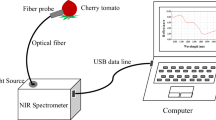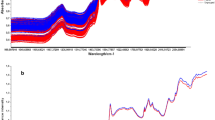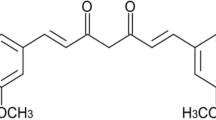Abstract
The purpose of this study was to investigate changes in water status and flavor characteristics of cucumbers during postharvest storage and to trace the quality attributes using partial least squares (PLS) and support vector machine (SVM). The results showed that four distinct water populations were identified in cucumbers by nuclear magnetic resonance (NMR), and the changes of water mobility and distribution occurred mainly in pulp of cucumbers. Flavor characteristics of cucumbers at different storage stages were distinguished by electronic nose (e-nose), and four clusters could be achieved through hierarchical clustering analysis. Comparison of two models, excellent prediction performances for firmness, pH, SSC, and ΔE of postharvest cucumbers were obtained using a combination method of e-nose technology and SVM algorithm. This study indicated that there were significant changes in the quality parameters of cucumbers during postharvest storage, which were related to water status and flavor characteristics. The combination of e-nose technology with the SVM algorithm offers a promising technique to monitor cucumber quality.





Similar content being viewed by others
References
Al-Juhaimi, F., Ghafoor, K., & Babiker, E. E. (2012). Effect of gum arabic edible coating on weight loss, firmness and sensory characteristics of cucumber (Cucumis sativus L.) fruit during storage. Pakistan Journal of Botany, 44(4), 1439–1444.
Bao, Y., Liu, F., Kong, W., Sun, D., He, Y., & Qiu, Z. (2014). Measurement of soluble solid contents and pH of white vinegars using VIS/NIR spectroscopy and least squares support vector machine. Food and Bioprocess Technology, 7(1), 54–61.
Barrett, D. M., Beaulieu, J. C., & Shewfelt, R. (2010). Color, flavor, texture, and nutritional quality of fresh-cut fruits and vegetables: desirable levels, instrumental and sensory measurement, and the effects of processing. Critical Reviews in Food Science and Nutrition, 50(5), 369–389.
Berna, A. (2010). Metal oxide sensors for electronic noses and their application to food analysis. Sensors, 10(4), 3882–3910.
Brosnan, T., & Sun, D. (2004). Improving quality inspection of food products by computer vision—a review. Journal of Food Engineering, 61(1), 3–16.
Caraux, G., & Pinloche, S. (2005). PermutMatrix: a graphical environment to arrange gene expression profiles in optimal linear order. Bioinformatics, 21(7), 1280–1281.
Cardenas-Coronel, W. G., Carrillo-Lopez, A., Velez, D. L. R. R., Labavitch, J. M., Baez-Sanudo, M. A., Heredia, J. B., Zazueta-Morales, J. J., Vega-Garcia, M. O., & Sanudo-Barajas, J. A. (2016). Biochemistry and cell wall changes associated with noni (Morinda citrifolia L.) fruit ripening. Journal of Agricultural and Food Chemistry, 64(1), 302–309.
Cascant, M. M., Sisouane, M., Tahiri, S., El Krati, M., Cervera, M. L., Garrigues, S., & de la Guardia, M. (2016). Determination of total phenolic compounds in compost by infrared spectroscopy. Talanta, 153, 360–365.
Chen, S., Zhang, R., Hao, L., Chen, W., & Cheng, S. (2015). Profiling of volatile compounds and associated gene expression and enzyme activity during fruit development in two cucumber cultivars. PLoS One, 10(3), 1–22.
Chen, Z., Zhu, C., Zhang, Y., Niu, D., & Du, J. (2010). Effects of aqueous chlorine dioxide treatment on enzymatic browning and shelf-life of fresh-cut asparagus lettuce (Lactuca sativa L.). Postharvest Biology and Technology, 58(3), 232–238.
Cho, B., Chayaprasert, W., & Stroshine, R. L. (2008). Effects of internal browning and watercore on low field (5.4 MHz) proton magnetic resonance measurements of T-2 values of whole apples. Postharvest Biology and Technology, 47(1), 81–89.
Concina, I., Falasconi, M., Gobbi, E., Bianchi, F., Musci, M., Mattarozzi, M., Pardo, M., Mangia, A., Careri, M., & Sberveglieri, G. (2009). Early detection of microbial contamination in processed tomatoes by electronic nose. Food Control, 20(10), 873–880.
Donglu, F., Wenjian, Y., Kimatu, B. M., Xinxin, A., Qiuhui, H., & Liyan, Z. (2016). Effect of nanocomposite packaging on postharvest quality and reactive oxygen species metabolism of mushrooms (Flammulina velutipes). Postharvest Biology and Technology, 119, 49–57.
Elena, V., Charles, D. L., P, L. J., Xuyen, P., & Pavinee, C. (2003). Water mobility in multicomponent model media as studied by 2H and 17O NMR. Journal of Agricultural and Food Chemistry, 51(6), 1647–1652.
Eysturskarð, J., Haug, I. J., Ulset, A., Joensen, H., & Draget, K. I. (2010). Mechanical properties of mammalian and fish gelatins as a function of the contents of α-chain, β-chain, and low and high molecular weight fractions. Food Biophysics, 5(1), 9–16.
Fadilah, N., Mohamad-Saleh, J., Halim, Z. A., Ibrahim, H., & Ali, S. S. S. (2012). Intelligent color vision system for ripeness classification of oil palm fresh fruit bunch. Sensors, 12(10), 14179–14195.
Fundo, J. F., Amaro, A. L., Madureira, A. R., Carvalho, A., Feio, G., Silva, C. L. M., & Quintas, M. A. C. (2015). Fresh-cut melon quality during storage: an NMR study of water transverse relaxation time. Journal of Food Engineering, 167, 71–76.
Fundo, J. F., Fernandes, R., Almeida, P. M., Carvalho, A., Feio, G., Silva, C. L., & Quintas, M. A. (2014). Molecular mobility, composition and structure analysis in glycerol plasticised chitosan films. Food Chemistry, 144, 2–8.
Fundo, J. F., Galvis-Sanchez, A., Madureira, A. R., Carvalho, A., Feio, G., Silva, C. L. M., & Quintas, M. A. C. (2016). NMR water transverse relaxation time approach to understand storage stability of fresh-cut ‘Rocha’ pear. LWT - Food Science and Technology, 74, 280–285.
Gao, D., Liu, Y., Meng, J., Jia, Y., & Fan, C. (2018). Estimating significant wave height from SAR imagery based on an SVM regression model. Acta Oceanologica Sinica, 37(3), 103–110.
Gómez, A. H., Hu, G., Wang, J., & Pereira, A. G. (2006). Evaluation of tomato maturity by electronic nose. Computers and Electronics in Agriculture, 54(1), 44–52.
Guohua, H., Yuling, W., Dandan, Y., Wenwen, D., Linshan, Z., & Lvye, W. (2012). Study of peach freshness predictive method based on electronic nose. Food Control, 28(1), 25–32.
Haddi, Z., Mabrouk, S., Bougrini, M., Tahri, K., Sghaier, K., Barhoumi, H., El Bari, N., Maaref, A., Jaffrezic-Renault, N., & Bouchikhi, B. (2014). E-nose and e-tongue combination for improved recognition of fruit juice samples. Food Chemistry, 150, 246–253.
Hong, X., Wang, J., & Qi, G. (2015). E-nose combined with chemometrics to trace tomato-juice quality. Journal of Food Engineering, 149, 38–43.
Hong, X., & Wang, J. (2014). Application of e-nose and e-tongue to measure the freshness of cherry tomatoes squeezed for juice consumption. Analytical Methods, 6(9), 3133.
Huang, L., Meng, L., Zhu, N., & Di, W. (2017). A primary study on forecasting the days before decay of peach fruit using near-infrared spectroscopy and electronic nose techniques. Postharvest Biology and Technology, 133, 104–112.
Jiang, S., & Wang, J. (2016). Internal quality detection of Chinese pecans (Carya cathayensis) during storage using electronic nose responses combined with physicochemical methods. Postharvest Biology and Technology, 118, 17–25.
Kerr, W. L., Clark, C. J., McCarthy, M. J., & de Ropp, J. S. (1997). Freezing effects in fruit tissue of kiwifruit observed by magnetic resonance imaging. Scientia Horticulturae, 69(3–4), 169–179.
Kjaer, A., Nielsen, G., Staerke, S., Clausen, M. R., Edelenbos, M., & Jorgensen, B. (2016). Prediction of starch, soluble sugars and amino acids in potatoes (Solanum tuberosum L.) using hyperspectral imaging, dielectric and LF-NMR methodologies. Potato Research, 59(4), 357–374.
Lagnika, C., Zhang, M., & Mothibe, K. J. (2013). Effects of ultrasound and high pressure argon on physico-chemical properties of white mushrooms (Agaricus bisporus) during postharvest storage. Postharvest Biology and Technology, 82, 87–94.
Li, T., Rui, X., Li, W., Chen, X., Jiang, M., & Dong, M. (2014). Water distribution in tofu and application of T2 relaxation measurements in determination of tofu’s water holding capacity. Journal of Agricultural and Food Chemistry, 62(34), 8594–8601.
Linden, V., & Baerdemaeker, J. (2005). The phenomenon of tomato bruising: where biomechanics and biochemistry meet. Acta Horticulturae, 2(682), 925–932.
Liu, C., He, Q., & Liu, Y. (2002). Head-space solid phase microextraction and GC-MS analysis of fragrance of cucumber. Acta Horticulturae Sinica, 29(6), 581–583.
Malegori, C., Nascimento, M. E., de Freitas, S. T., Pimentel, M. F., Pasquini, C., & Casiraghi, E. (2017). Comparing the analytical performances of micro-NIR and FT-NIR spectrometers in the evaluation of acerola fruit quality, using PLS and SVM regression algorithms. Talanta, 165, 112–116.
Manjunatha, M., & Anurag, R. K. (2014). Effect of modified atmosphere packaging and storage conditions on quality characteristics of cucumber. Journal of Food Science and Technology, 51(11), 3470–3475.
Marigheto, N., Venturi, L., & Hills, B. (2008). Two-dimensional NMR relaxation studies of apple quality. Postharvest Biology and Technology, 48(3), 331–340.
Mazhar, M., Joyce, D., Cowin, G., Brereton, I., Hofman, P., Collins, R., & Gupta, M. (2015). Non-destructive 1H-MRI assessment of flesh bruising in avocado (Persea americana M.) cv. Hass. Postharvest Biology and Technology, 100, 33–40.
Mehyar, G. F., Al-Qadiri, H. M., Abu-Blan, H. A., & Swanson, B. G. (2011). Antifungal effectiveness of potassium sorbate incorporated in edible coatings against spoilage molds of apples, cucumbers, and tomatoes during refrigerated storage. Journal of Food Science, 76(3), M210–M217.
Meng, X., Zhang, M., Zhan, Z., & Adhikari, B. (2014). Changes in quality characteristics of fresh-cut cucumbers as affected by pressurized argon treatment. Food and Bioprocess Technology, 7(3), 693–701.
Mohammadi, A., Hashemi, M., & Hosseini, S. M. (2016). Postharvest treatment of nanochitosan-based coating loaded with Zataria multiflora essential oil improves antioxidant activity and extends shelf-life of cucumber. Innovative Food Science and Emerging Technologies, 33, 580–588.
Møller, S. M., Travers, S., Bertram, H. C., & Bertelsen, M. G. (2013). Prediction of postharvest dry matter, soluble solids content, firmness and acidity in apples (cv. Elshof) using NMR and NIR spectroscopy: a comparative study. European Food Research and Technology, 237(6), 1021–1024.
Mubarok, S., Okabe, Y., Fukuda, N., Ariizumi, T., & Ezura, H. (2016). Favorable effects of the weak ethylene receptor mutation Sletr1-2 on postharvest fruit quality changes in tomatoes. Postharvest Biology and Technology, 120, 1–9.
Raffo, A., Gianferri, R., Barbieri, R., & Brosio, E. (2005). Ripening of banana fruit monitored by water relaxation and diffusion 1H-NMR measurements. Food Chemistry, 89(1), 149–158.
Roudaut, G., Simatos, D., Champion, D., Contreras-Lopez, E., & Le Meste, M. (2004). Molecular mobility around the glass transition temperature: a mini review. Innovative Food Science and Emerging Technologies, 5(2), 127–134.
Sanaeifar, A., Mohtasebi, S. S., Ghasemi-Varnamkhasti, M., & Ahmadi, H. (2016a). Application of MOS based electronic nose for the prediction of banana quality properties. Measurement, 82, 105–114.
Sanaeifar, A., Mohtasebi, S. S., Ghasemi-Varnamkhasti, M., & Ahmadi, H. (2016b). Application of MOS based electronic nose for the prediction of banana quality properties. Measurement, 82, 105–114.
Shao, J., Deng, Y., Song, L., Batur, A., Jia, N., & Liu, D. (2016). Investigation the effects of protein hydration states on the mobility water and fat in meat batters by LF-NMR technique. LWT Food Science and Technology, 66, 1–6.
Song, S., Yuan, L., Zhang, X., Hayat, K., Chen, H., Liu, F., Xiao, Z., & Niu, Y. (2013). Rapid measuring and modelling flavour quality changes of oxidised chicken fat by electronic nose profiles through the partial least squares regression analysis. Food Chemistry, 141(4), 4278–4288.
Techakanon, C., & Barrett, D. M. (2017). The effect of calcium chloride and calcium lactate pretreatment concentration on peach cell integrity after high-pressure processing. International Journal of Food Science and Technology, 52(3), 635–643.
Tu, S. S., Choi, Y. J., McCarthy, M. J., & McCarthy, K. L. (2007). Tomato quality evaluation by peak force and NMR spin-spin relaxation time. Postharvest Biology and Technology, 44(2), 157–164.
Wang, C., Mao, M., Hu, F., Yu, Y., He, J., & Zhu, S. (2013). Comparison of sensory quality between subjective evaluation and instrument detection for cucumber juice with high pressure processing and heat treatment. Transactions of the Chinese Society of Agricultural Engineering, 29(10), 278–286.
Wang, L., Baldwin, E. A., & Bai, J. (2016). Recent advance in aromatic volatile research in tomato fruit: the metabolisms and regulations. Food and Bioprocess Technology, 9(2), 203–216.
Wang, L., Xu, B., Wei, B., & Zeng, R. (2018). Low frequency ultrasound pretreatment of carrot slices: effect on the moisture migration and quality attributes by intermediate-wave infrared radiation drying. Ultrasonics Sonochemistry, 40(A), 619–628.
Wang, Y., Xie, X., & Long, L. E. (2014). The effect of postharvest calcium application in hydro-cooling water on tissue calcium content, biochemical changes, and quality attributes of sweet cherry fruit. Food Chemistry, 160, 22–30.
Yang, H., Ding, L., An, L., Xiang, Z., Chen, M., Zhou, J., Li, F., Wu, D., & Yang, S. (2012). A d-f heteronuclear complex for dual-mode phosphorescence and magnetic resonance imaging. Biomaterials, 33(33), 8591–8599.
Zawirska-Wojtasiak, R., Gośliński, M., Szwacka, M., Gajc-Wolska, J., & Mildner-Szkudlarz, S. (2009). Aroma evaluation of transgenic, thaumatin II-producing cucumber fruits. Journal of Food Science, 74(3), C204–C210.
Zhang, H., Wang, J., & Ye, S. (2008). Prediction of soluble solids content, firmness and pH of pear by signals of electronic nose sensors. Analytica Chimica Acta, 606(1), 112–118.
Funding
Financial support was by Jiangsu Province (China) Key Project in Agriculture (Contract No. BE2015310217), National First-class Discipline Program of Food Science and Technology (No. JUFSTR20180205), and Jiangsu Province Key Laboratory Project of Advanced Food Manufacturing Equipment and Technology (No. FMZ201803), which enabled carrying out this study.
Author information
Authors and Affiliations
Corresponding author
Ethics declarations
Conflicts of Interest
The authors declare that they have no conflict of interest.
Rights and permissions
About this article
Cite this article
Feng, L., Zhang, M., Bhandari, B. et al. Determination of Postharvest Quality of Cucumbers Using Nuclear Magnetic Resonance and Electronic Nose Combined with Chemometric Methods. Food Bioprocess Technol 11, 2142–2152 (2018). https://doi.org/10.1007/s11947-018-2171-9
Received:
Accepted:
Published:
Issue Date:
DOI: https://doi.org/10.1007/s11947-018-2171-9




